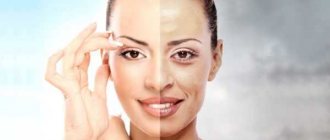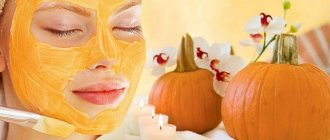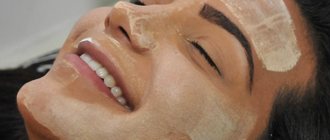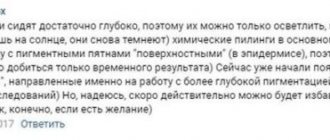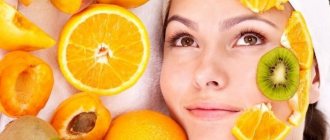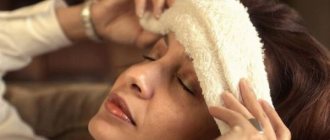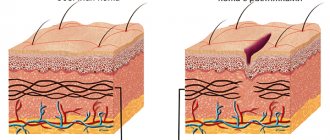Pyruvic peeling (pyruvate, green) is a procedure that has become widespread in cosmetology. The key component is pyruvic acid. The molecules of this substance are small and penetration is optimal. But the most important thing is that pyruvic acid is in the body of each of us - and the skin accepts it well. Professionals carry out the procedure using various mixtures, combining the pyruvic mixture with lactic acid in various percentages. The concentration of the substance in the mixture depends on the purpose and purpose of the peeling.
Pyruvic acid works as follows: it is applied to the skin and the molecules of the substance begin to actively interact with the upper layers of the dermis, and keratinized cells are dissolved and then removed from the surface of the epidermis. Thus, the acid triggers regeneration processes and has a beneficial effect on the skin, promoting effective results.
What is pyruvic peeling?
The cosmetic procedure helps smooth out small wrinkles, reduce deep wrinkles, improve skin color, and reduce skin oiliness. Pores are narrowed and deeply cleansed, and cellular metabolism is accelerated. Pyruvic acid peeling is recommended for women after thirty years of age as a procedure that helps remove early signs of aging. After forty years (deep wrinkles), it is recommended to use other, more intensive treatment methods.
There are three types of pyruvic mixture that experts use
- 50% pyruvic acid and 5% lactic acid. This composition helps to rejuvenate the skin and eliminate increased pigmentation;
- pyruvic and lactic acid (25% in equal shares). The resulting substance is used to treat and rejuvenate sensitive and dark skin. It is also used for pre-treatment of problem areas if the client is expecting deep or superficial peeling;
- pyruvic acid (40%) and lactic acid (5%). Used to regulate the secretion of sebaceous secretions, cleanse the face, and neutralize skin rashes.
Indications for pyruvic peeling are:
- acne, blackheads and other skin problems. For these diseases, peeling is carried out once every eight days;
- increased skin pigmentation. Peeling is carried out once every ten days;
- skin withering. Peeling is carried out once every two weeks;
- seborrheic dermatitis;
- Rosacea.
Contraindications to the procedure
- pregnancy;
- acute stage of internal organ disease;
- postpartum period;
- breastfeeding a child;
- damage to the skin - scratches, burns, infectious diseases, cancer;
- diabetes;
- bronchial asthma;
- viral infections, colds;
- individual intolerance to components.
Indications
Peeling with 2-oxopropanoic acid is recommended for oily, combination and problem skin with:
- prevention of photoaging;
- leveling the relief (smoothing wrinkles);
- treatment of oily seborrhea;
- removal of acne, rosacea and comedones.
Exfoliation can be recommended if skin elasticity (tone) decreases due to age-related changes.
The peculiarity of the procedure is its effectiveness when used for dark and dense skin.
Stages of pyruvic acid peeling
- 7-14 days before the start of the procedure, you should start treating the skin with products that contain glycolic acid. Thanks to this, the skin will better accept the procedure. To eliminate inflammation, additional means are used;
- You should stop smoking six weeks before the start - this will shorten the period of skin regeneration. You should not use aspirin and anti-inflammatory drugs (a cosmetologist should tell you about the list). Also consult a specialist about what herbal infusions to take, as this affects skin coagulation;
- Before starting peeling, the cosmetologist must cleanse the skin: remove foreign impurities, remove makeup, and remove excess sebum. The specialist applies a special exposure to the skin, which should last up to fifteen minutes. The cosmetologist will determine the duration of the procedure;
- after fifteen minutes, the specialist removes the exposure from the face and applies nourishing, tonic products designed to protect the skin from sun exposure and soothe it;
- The final stage is skin restoration. And it rests entirely with the patient. If the procedure was carried out in a beauty salon, then consult your cosmetologist. He will help you choose care products. In order to avoid infection of the epidermis, it should be periodically treated with Miramistin. You cannot go out in the sun for 14 days without protective equipment. Visits to saunas, swimming pools, and solariums are excluded.
Pharmacy drugs
Pyruvic acid is very unstable and easily decomposes in air. It is used in cosmetics in combination with stabilizers such as vitamin C, azulenoic acid and its derivatives.
The specific smell is masked with essential oils (blood orange, grapefruit).
The products are packaged in ampoules designed for one use or in bottles with a dispenser.
Clarena cream and serum
Cream (Clarena), which contains 3% pyruvic and 10% azulenoic acids, is intended for intensive rejuvenation of the epidermis. It is used at night, applied to a dry face after cleansing.
Recommended after 40 years of age with obvious signs of aging and fading.
Serum with glycerin in ampoules of 5 ml (Clarena) with a concentration of 5% for the treatment of oily seborrhea, acne, used at night.
The product is recommended at any age in combination with Panthenol cream, which is applied in the morning.
Mesopharm Professional
Serum with a 5% concentration , enriched with retinol and ascorbic acid (Mesopharm Professional) is used in the treatment of rosacea, acne, age spots, and the initial stage of photoaging.
The drug is used starting from 16 years of age in the presence of problematic epidermis of oily and combination type.
Biomaris
Mask containing 10% pyruvic acid (Biomaris) , sealed in 5 ml ampoules. Purposes of use: removal of acne, comedones, rejuvenation (lifting), lightening, prevention of photoaging.
The product is used in combination with an appropriate cream (Clarena) to increase the anti-aging effect in women with noticeable aging of the epidermis or separately from it, applying a moisturizing gel after use.
Before using pharmaceutical drugs, it is advisable to consult a professional cosmetologist.
Home treatments
Pyruvic acid peeling can be done at home. The procedure is divided into the following sequential steps:
- Soak a cotton sponge in lemon juice and sprinkle it with a small amount of sugar. When the granules are slightly melted, clean and steam the skin;
- then start wiping your face with a sponge: the juice will dissolve dead skin tissue, and the sugar granules will remove them;
- Another way is to mix soda with kefir. The resulting thick mass should be applied to the face;
- In summer, fresh berries (strawberries, strawberries, raspberries) can be used as a peeling agent. The berry components should be ground into a paste and mixed with white clay. Apply the substance to steamed skin, and then rinse with water;
- Grind bread crumbs in a coffee grinder, then combine a tablespoon with almond flour, add strong green tea and treat your face with this mixture;
- combine low-fat cottage cheese with cane sugar, then gently massage problem areas of your face.
If you are going to be treated by a cosmetologist, then he should:
- inform about what treatment regimen he will carry out;
- make forecasts about expected results;
- calculate the cost of treatment;
- inform you about what risks and complications you may expect;
- Give thorough instructions on preparation for the procedure and recovery period.
- show photos of your clients. See with your own eyes what clients looked like before and after the procedure.
For the full effect - to get rid of pronounced defects, the client may need up to ten procedures.
It is not recommended to carry out the procedure in summer, since the skin is sensitive to ultraviolet radiation after removing the layer of keratinized cells. Therefore, it is better to carry out pyruvic peeling in autumn or winter, and not in the hot season.
Finally
With pyruvic peeling you can do a mid-superficial or superficial cleansing. During the procedure, dead cells are removed. Acne and age spots are also removed, and the skin is rejuvenated. The experience of women who have trusted this method suggests that this procedure is quite effective. The main thing is to carefully follow all prescribed instructions and, if possible, consult a specialist.
Advantages of the method
Pyruvate peeling is a fairly gentle method of caring for aging and problematic skin, while it is highly effective and safe. One of the important advantages of this procedure is the high degree of lipophilicity, that is, the chemical structure of the active component is as close as possible to organic substances and natural elements of the skin. This property ensures rapid and uniform penetration of pyruvates into various layers of the skin and allows you to control the depth of exposure to prevent excessive exposure and chemical damage to the epidermal structures.
Pyruvate peeling is a gentle skin care technique.
High lipophilicity is not the only advantage of pyruvates over other types of chemical peels. The procedure has several other significant characteristics that allow it to be used for skin care of any phototype and with varying degrees of sensitivity. These include:
- good tolerance. Most patients tolerate the procedure quite well, complaining only of moderate tingling during the session itself and slight redness of the skin for 2-3 days after its completion;
- high bioavailability. The drug perfectly penetrates not only into the various layers of the dermis and epidermis, but also into the pilosebaceous structures (hair follicles, sebaceous glands);
- low degree of dehydration compared to other chemical peels. The breakdown into lactic acid molecules allows the use of pyruvate peeling even on dry skin, which is not always possible with other cosmetics;
- stimulating natural skin renewal. Pyruvic acid activates the production of the dermis’ own fibrillar components (elastin and collagen), which helps smooth the skin, even out its contours and rejuvenate.
Pyruvic acid helps smooth out fine wrinkles and stimulates skin regeneration
The pyruvates in the peeling have a gentle effect on the skin, without causing any tightening or peeling effects. Side effects of the procedure in the form of moderate dryness and redness are mild and disappear completely within a few days.
Pyruvic acid peeling: real review
I've heard a lot about this procedure. Finally, I made up my mind. The procedure takes place in 5 stages:
- Degrease the skin with an alcohol solution.
- Apply the acid with a cotton swab.
- Give time for the reaction to convert pyruvic acid into lactic acid.
- We apply a neutralizer.
- Allow the skin to dry.
To evaluate the effectiveness of the procedure, I will attach my before and after photos:
The downside for me is the unpleasant smell and slight burning of the skin, but the beauty of my face is worth it. The skin is smooth and soft to the touch. Immediately after the procedure, I was slightly reddish, but it went away quickly) I was very pleased with the result. No greasy shine, beauty
Rules of application
Before carrying out salon pyruvic exfoliation, the skin needs preparation , which consists of two sessions of fruit peeling with an interval of 15 days and daily use of moisturizing preparations with hyaluronic acid for two weeks.
Gentle exfoliation at home involves only two weeks of moisturizing without peeling with AHA acids.
Also, 15 days before the procedure, you must refrain from solarium, tanning, taking retinoid medications, and alcohol.
Post-peeling care after green exfoliation is very simple:
- During the day, you should not wash your face with water or treat it with cosmetics, and in case of redness and irritation, use powder (buy at a pharmacy).
- A day later, for a week, smear your face with Panthenol cream (in the morning) or any other cream as recommended by a cosmetologist. Then you can proceed to normal care.
- Before going out into direct sunlight, be sure to apply a product with a high spf (50 or more).
To obtain a lasting result, it is necessary to undergo a course of pyruvin exfoliation , which consists of 4-5 sessions with an interval of 10-12 days.
Precautionary measures
Before testing, it is necessary to test the composition for an allergy test to exclude unwanted reactions. also a number of contraindications for carrying out:
- pregnancy, lactation;
- spring-summer period;
- damage to the integrity of the integument;
- viral infections;
- dermatological diseases;
- herpes;
- fresh tan;
- rosacea;
- bronchial asthma;
- pathologies of the respiratory system;
- oncology;
- diabetes;
- individual intolerance.
If the acid concentration is incorrectly chosen, the exfoliation protocol is violated, or the patient does not comply with the recovery rules, complications are possible:
- increasing hyperemia;
- itching, burning, irritation;
- swelling;
- tissue inflammation;
- hyperpigmentation;
- dryness, feeling of tightness;
- exacerbation of acne.
Attention! If side effects occur, consultation and correction of symptoms with a specialist is necessary.
Question answer
Under no circumstances should you carry out the green peeling procedure yourself at home.
Only a specialist will be able to correctly assess the condition of the skin, as well as prescribe the concentration of the active substance, and develop an individual post-peeling care regimen. Of course, you can buy a composition for pyruvic acid peeling on your own, but in this case the patient risks causing irreparable harm to his body. One peeling session with pyruvic acid usually lasts from 30 minutes to 1 hour.
When applying the full course of treatment, the patient experiences the following results: reduction of shallow wrinkles (in some cases, even their complete elimination), tightening of the oval of the face, improvement of the processes of natural renewal of the skin, complexion, disappearance (complete or partial) of age spots, cure acne, eliminating traces of post-acne, normalizing fat secretion in the epidermis, the skin becomes cleaner and matte.
Can it be done at home?
Modern cosmetology gives an unequivocal answer to the question posed: no. Due to the high probability of getting a chemical burn if you handle acids carelessly, it is not recommended to perform the procedure at home. Only a professional cosmetologist will be able to determine the composition and required concentration of the substance.
Many women, despite warnings, carry out the procedure on their own. However, it is worth remembering that any wrong step can lead to dangerous consequences. Facial skin is a person’s calling card, so it is better to have qualified specialists work with it.
Side effects and contraindications
Pyruvate peeling is a fairly gentle procedure, but it also has certain side effects that you need to be prepared for. These include:
- redness (erythema) and dry skin, flaking and a feeling of tightness;
- tingling and burning sensation for 2-3 days after the procedure;
- increased sensitivity to external influences and sunlight.
One of the severe side effects of pyruvic exfoliation is bronchospasms in people suffering from chronic pathologies of the respiratory tract, in particular bronchial asthma. Pyruvic acid has a very pungent odor, so the room in which the procedure is performed must be well ventilated throughout the session.
In asthmatics, pyruvate peeling may cause bronchospasms
Contraindications
Despite its gentle effect on the skin, pyruvic peeling is not suitable for all patients and has certain contraindications, which you need to inform your cosmetologist about. The procedure should not be performed on patients with a long-term or preliminary history of the following pathologies:
- oncological diseases;
- herpetic disease;
- inflammatory skin pathologies in the acute stage;
- diseases of the hematopoietic system;
- diabetes mellitus in the stage of decompensation;
- severe pathologies of the bronchopulmonary system.
Peeling is contraindicated for herpes
Pyruvate peeling is not recommended for patients who require systemic or local hormonal therapy. The use of pyruvic acid (including inhalation of its vapors) is prohibited for pregnant and lactating women and persons with signs of damage to the integrity of the skin at the site of application.


